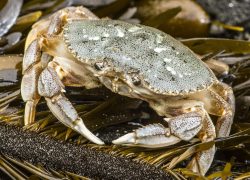
New research on the Pacific Northwest portion of the Dungeness crab fishery, which spans the West Coast of the U.S. and Canada, projects how this crustacean will fare under climate change.
Results show that by the end of this century, lower-oxygen water will pose the biggest threat. And while these crabs start as tiny, free-floating larvae, it’s the sharp-clawed adults that will be most vulnerable, specifically to lower-oxygen coastal waters in summer.
The open-access study from researchers at the University of Washington, the University of Connecticut and the National Oceanic and Atmospheric Administration will be in the December issue of AGU Advances, a journal of the American Geophysical Union.
Dungeness crab is the largest single-species fishery in the Northwestern U.S. Washington’s Dungeness Crab Festival takes place in October near the Dungeness Cove that gives the species its name, and the crustacean is a favorite of Pacific Northwest holiday meals and in traditional diets. The study was designed in consultation with the Hoh, Makah, Quileute and Quinault Indian Nation tribes, whose members harvest, study and eat Dungeness crab on Washington’s Olympic Peninsula.
The researchers used a detailed computer model of ocean conditions to simulate the shifting properties of the water the crabs inhabit. Using a scenario of high carbon emissions through 2100, the model looks at how heat-trapping gases in the atmosphere will make the ocean warmer, carbon dioxide transferred from the air will make the surface waters more acidic, and warmer water will hold less dissolved oxygen.
“The value of this down-scaled model is that it can help tribes and state agencies to focus their efforts in both space and time,” said co-author Jan Newton, an oceanographer at UW and co-director of the Washington Ocean Acidification Center. “This information is very pertinent to resource managers.”
Read more at UW News »
